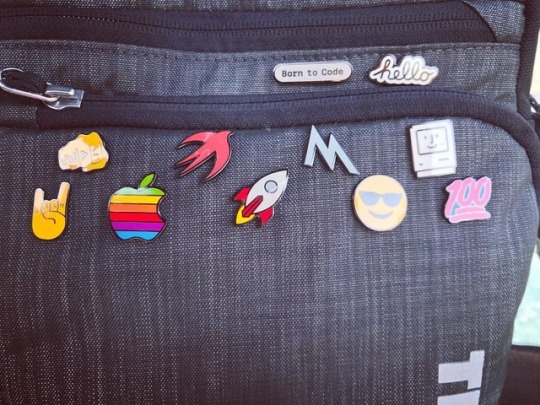I engineer software and enjoy working on very complex mathematical problems. I drink, eat, dream and produce Cocoa everyday for living. You can find more about me at http://www.invasivecode.com
Don't wanna be here? Send us removal request.
Photo

Oh yeah #wwdc2017 (at Los Angeles, California)
1 note
·
View note
Video
SignaKit - Handwritten Signature Framework for iOS from iNVASIVECODE on Vimeo.
SignaKit is a high-level iOS framework that helps you create handwritten signatures and add them to PDF documents. It is fine tuned for the Apple Pencil and saves you hours of development. SignaKit reads PDF documents and collects biometric features for online signature verification.
2 notes
·
View notes
Photo

Apple App Distribution
Companies often ask us for advice in what the current possibilities are for developing an app for their own use inside the company. Sometimes they are confused about which Apple Developer Program they have to choose, or how to distribute the app to their employees, or if they have to publish that App on the App Store or not. They have heard of MDM, VPP, Custom B2B, Enterprise Program and other acronyms and want to put the pieces of the puzzle in the right place. I will try to do that in this post.
Keep reading
2 notes
·
View notes
Photo

Replicator Layer
In this tutorial I am going to show you how to create a very interesting animation with replicator layers, instances of the CAReplicatorLayer class. After building so many apps and using every single framework of Cocoa Touch, every time I build something new for a customer, I feel the need to spend some time researching new functionalities and interaction patterns to make the solution we provide really unique. Most of the time, I focus on usability and try to push the limits of Cocoa Touch.
Keep reading
1 note
·
View note
Photo

Capture Video with AVFoundation and Swift
AVFoundation allows you to capture multimedia data generated by different input sources (camera, microphone, …) and redirect them to any output destination (screen, speakers, render context, …).
Some years ago, I wrote this post on how to build a custom video camera based on AVFoundation using Objective-C. At that time, Swift did not exist. Recently, we received so many requests to show how to build the same custom video camera using Swift. So, here I am going to show you how to do that.
Keep reading
3 notes
·
View notes
Photo

Metal: Blazing Fast Image Processing
Introduced in iOS 8 by Apple, Metal allows developers to perform graphics rendering and parallel computing directly on the GPU. Before Metal, OpenGL ES was the framework available on iOS to perform graphics rendering. Instead, parallel computing using the GPU was only available on OS X through OpenCL. Recently, Apple brought Metal also to OS X. Apple also extended Metal with new features and two new companion frameworks: MetalKit and Metal Performance Shaders.
Keep reading
4 notes
·
View notes
Photo

Custom View Controller Transitions and Storyboard
A few weeks ago, I wrote this post about the storyboard’s features introduced in iOS 9. In that post, I mentioned that you can now trigger a custom view controller transition through storyboard segues. Starting from iOS 9, you can perform view controller transitions using the new APIs introduced by Apple first in iOS 7 and, then slightly modified in iOS 8. These APIs use dedicated objects to control the transition animations. In this post, I am going to show you how to use these APIs and trigger these animations from the storyboard.
Keep reading
4 notes
·
View notes
Photo

UIPopoverPresentationController and UISearchController
UIPresentationController is the presentation management class that backs view controllers presentation. From the time a view controller is presented until the time it is dismissed, UIKit uses a presentation controller to manage various aspects of the presentation process for that view controller. The presentation controller can add its own animations on top of those provided by animator objects, respond to size changes, and manage other aspects of how the view controller is presented onscreen.
Keep reading
4 notes
·
View notes
Photo

iOS Crash Reporters
Nobody likes it when an App crashes. You don’t like it and neither do your users. And when your App crashes, you, as the developer, are very interested in knowing why, as soon as possible. You want to know what is causing the crash so you can fix it. To do so, it’s invaluable to have crash reports delivered to you and your team without delay. And that is why you install a framework to detect crashes and generate crash reports.
Keep reading
2 notes
·
View notes
Photo

Dynamic animation system: UIFieldBehavior
Dynamic animation is an area of science concerned with the behavior of physical bodies when they are subjected to forces or displacements, and the subsequent effects of those bodies on their environment. In iOS app development, dynamic animation represents simplified physics that is useful for building a prototype model, well-tuned for performance. However, bear in mind that the dynamic animation system is a 2D physics inspired animation system, no real physics are used here! Moreover, bear in mind that the dynamic animations that I will show here are a part of UIKit. Hence, they are intended for UI and not for building video games. If you want to build a video game, you should instead use Sprite Kit, which provides its own physics engine.
Keep reading
1 note
·
View note
Photo

Advanced CloudKit (Part III)
This is the third part of a trilogy of posts about Apple’s CloudKit. In [the first part][1], I showed you how to manage critical data. [The second part][2] was about updating a large amount of data on Cloud Kit. And in this third part, we will learn how to use subscriptions so that we will be notified when the data changes in CloudKit.
Keep reading
2 notes
·
View notes





